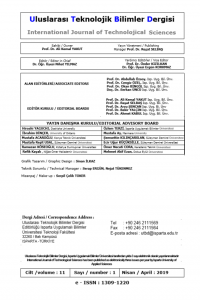Abstract
The context of the nonlinearity provided by a building is based on the behaviors of structural components; beams, columns and their connections constituting the seismic force resisting system of the structure. Of these members, beam-to-column connections can play a considerably important role even if they have a capability of limited stiffness and flexural strength. Structural steel connections are mainly classified as a pinned or a moment connection. However, some beam-to-column connections having limited stiffness and flexural strength, which are called semi-rigid connections such as header end-plate connections can be characterized by moment-rotation relationship. For this characterization, the effect of some parameters such as thickness of the header end-plate, depth of the connection and number of the bolt rows on the behavior of header end-plate connections has been investigated by the help of finite element (FE) models. These models include material, geometrical and contact nonlinearities. Each material for each member is defined by true stress-true strain curve. According to the analyses results, in addition to shear stresses, axial tensile stresses have been observed to occur in the bolts at the tension side. Thickness of the header end-plate, depth of the connection and beam web play a governing role in the development of initial rotational stiffness and the flexural strength of the header end-plate connections. However, for the equal connection depth, increasing the number of bolt rows has not influenced the connection behavior remarkably. An additional study has also been conducted on yield line analysis to identify the behaviors of header end-plates. Analyses results have shown that header end-plate connections have limited stiffness and flexural strength. However, they seem to be promising to provide the structural systems with additional stiffness, ductility and strength.
References
- AISC, Load and Resistance Factor Design Specifications for Structural Steel Buildings, 2nd edition, American Institute of Steel Construction, Chicago, 1994.
- Aggarwal, A.K. (1990). Behaviour of Flexible End Plate Beam-to-Column Joints. Journal of Constructional Steel Research, 16, 111–134.
- Bruneau, M., Uang, C.M., Sabelli, R. (2011). Ductile Design of Steel Structures, second ed., McGraw Hill, New York.
- Chen, W., Kishi, N., Komuro, M. (2011). Semi-Rigid Connections Handbook. J. Ross Publishing, U.S.A.
- Karasu, A., Vatansever, C., Alçiçek, H.E. (2018). An investigation of the behavior of header end-plate connections under monotonic loading. Challenge Journal of Structural Mechanics, Vol. 4, No. 3 / 2018, 108-116.
- Kishi, N., Komuro, M., Chen, W. (2004). Four-parameter power model for Moment-rotation curves of end-plate connections. ECCS/AISC Workshop Connections in Steel Structures V, (c), 99–110, Amsterdam, The Netherlands.
- Pilgr, D.M. (2009). Experimental verification of actual behavior of header plate connections. The Nordic Steel Construction Conference.
- Sommer, W.H. (1969). Behaviour of Welded Header Plate Connections. University of Toronto, Master’s thesis, Toronto, Canada
- TCDCSS (2016). Turkish code for design and construction of steel structures 2016, Ministry of Environment and Urbanisation, Ankara, Turkey. 33
Abstract
References
- AISC, Load and Resistance Factor Design Specifications for Structural Steel Buildings, 2nd edition, American Institute of Steel Construction, Chicago, 1994.
- Aggarwal, A.K. (1990). Behaviour of Flexible End Plate Beam-to-Column Joints. Journal of Constructional Steel Research, 16, 111–134.
- Bruneau, M., Uang, C.M., Sabelli, R. (2011). Ductile Design of Steel Structures, second ed., McGraw Hill, New York.
- Chen, W., Kishi, N., Komuro, M. (2011). Semi-Rigid Connections Handbook. J. Ross Publishing, U.S.A.
- Karasu, A., Vatansever, C., Alçiçek, H.E. (2018). An investigation of the behavior of header end-plate connections under monotonic loading. Challenge Journal of Structural Mechanics, Vol. 4, No. 3 / 2018, 108-116.
- Kishi, N., Komuro, M., Chen, W. (2004). Four-parameter power model for Moment-rotation curves of end-plate connections. ECCS/AISC Workshop Connections in Steel Structures V, (c), 99–110, Amsterdam, The Netherlands.
- Pilgr, D.M. (2009). Experimental verification of actual behavior of header plate connections. The Nordic Steel Construction Conference.
- Sommer, W.H. (1969). Behaviour of Welded Header Plate Connections. University of Toronto, Master’s thesis, Toronto, Canada
- TCDCSS (2016). Turkish code for design and construction of steel structures 2016, Ministry of Environment and Urbanisation, Ankara, Turkey. 33
Details
| Primary Language | English |
|---|---|
| Subjects | Material Production Technologies |
| Journal Section | Articles |
| Authors | |
| Publication Date | May 31, 2019 |
| Published in Issue | Year 2019 Volume: 11 Issue: 1 |

